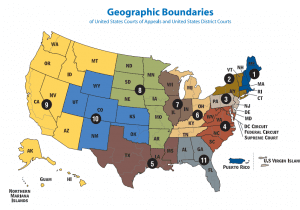Could Congress Break Up or Abolish the 9th Circuit?
The politically motivated decisions coming from the 9th Circuit Court of Appeals have members of Congress considering legislation to break up the liberal mid-level court.
What is the Ninth Circuit Court of Appeals

The Ninth is the largest of the 12 regional circuits, each of which contains an appellate court. There are 29 judge’s seats on the court’s full panel although two are currently vacant[1]. The circuit presides over the 9 western states of Arizona, California, Alaska, Nevada, Idaho, Oregon, Montana, Washington and Hawaii, and the territories of Guam and the Northern Mariana Islands. The court hears more cases than any other at the appellate level.
Appellate courts are the middle level of the judiciary branch of the U.S. government. District courts first hear cases which can then be appealed to the presiding circuit court should either party object to the district court’s decision. An appeal of a circuit court decision goes to the Supreme Court of the United States. A Supreme Court decision cannot be appealed, but in rare cases, they may agree to rehear a case if new and compelling arguments are brought forward.
What’s wrong with the 9th Circuit Court of Appeals
The 9th circuit’s size is one issue. Because the court has so many judges, cases are initially decided by a random panel of three and if they disagree, an en banc panel of 11 judges – 10 of which are randomly chosen: “leading to often inconsistent and conflicting opinions, and giving rise to a body of law that is neither uniform nor predictable. With a procedure that limits the number of judges resolving these conflicts to eleven, ten of which are chosen by lot, it is no wonder that the Ninth fails to provide the stability and predictability that are virtues of a legal system.”[2]
In a 2005 interview on PBS, 9th Circuit Court Judge Diarmuid O’Scannlain said, “We get consistently criticized because people will find a case of our court that says one thing here, and then another case, again from our court from a different panel, that says something totally inconsistent.”
The 9th also has a bad habit of incorrectly interpreting the Constitution. In a 2010 study, the American Bar Association found that the Supreme Court had overturned and vacated 80% of the cases that it reviewed from the 9th Circuit – a rate higher than any other regional circuit court.[3].
“The 9th Circuit has a well-earned reputation for being presumptively reversible,” Rep. Trey Gowdy (R-SC) said in a statement after 9th Circuit decided to keep an injunction in place against President Donald Trump’s travel order preventing people from six Middle-East Nations from entering the United States.
Famous cases decided, then reversed by the Supreme Court illustrate a view out-of-synch with the Consitution.
- Newdow v. United States Congress, Elk Grove Unified School District, et al: In 2002, the 9th ruled that “under God” in the Pledge of Allegiance was an endorsement of a religion
- overturned by SCOTUS in 2004 decision on Elk Grove Unified School District v. Newdow
- Silveira v. Lockyer: 2002 the 9th decided that the Second Amendment does not guarantee an individual’s right to bear arms
- The Supreme Court initially refused to hear the case, but with the District of Columbia v. Heller decision in 2008, Silveira v. Lockyer was overruled
- Washington v. Glucksberg: 1995 9th Decided that laws banning assisted suicide were unconstitutional.
- 2007 – The Supreme Court reversed the 9th’s ruling
- Donald J. Trump, President of the United States, et al. v. International Refugee Assistance Project et al.: 2017 – 9th Circuit upholds an injunction against Trump’s travel order.
- 2017 – Supreme Court unanimously decides to overturn the injunction for all but a small portion of the order.
Can Congress Break-up or abolish the 9th Circuit
A report issued by the 1973 Hruska Commission recommended that the 5th and 9th be broken apart due to a burgeoning case load.
One bill, sponsored by Sens. Jeff Flake and John McCain of Arizona, seeks to break the Ninth Circuit into two parts. Another, that would break it into three, is expected next month. Neither disbands the court nor will they force any judges out. The only known instance of Congress abolishing a court was in the Judiciary Act of 1802 which was upheld by the Supreme Court in its 1803 decision on Stuart v. Laird.
Splitting the 9th has struggled each time it has been brought up. Even if the 9th were just made up of California, it would still have a higher case load than any other circuit and the court would likely become completely liberal.
There is a precedent for a break-up. New York and New Jersey were split up in the 1800’s and the Northeast is heavily segmented with most circuits covering three states or less.
There is not likely enough political will among Republicans to push through a split-up, much less outright abolishment.
Sources:
[1] Circuit Judges – United States Courts for the Ninth Circuit. (n.d.). Retrieved June 28, 2017, from USCourts.gov
[2] Suarez, A. (1989, June 14) No More Justice Delayed: Time To Divide the Ninth Circuit Court of Appeals. Retrieved from Heritage.org
[3] Hofer, R. (2010, January) Supreme Court Reversal Rates: Evaluating the Federal Courts of Appeals. Retrieved from the American Bar Association
The Latest News on the 9th Circuit Court of Appeals
[feed url=”https://www.conservativedailynews.com/tag/9th-circuit-court-of-appeals/feed/” number=”15″ ]




